| University of Birmingham | |
|---|---|
 Shield from the arms of the University of Birmingham | |
| Motto | Latin: Per Ardua Ad Alta |
| Motto in English | "Through efforts to high things" |
| Established | 1900 - gained University Status by Royal Charter 1825 - Medical School |
| Type | Public |
| Endowment | £85 million |
| Chancellor | Sir Dominic Cadbury |
| Vice-Chancellor | Professor David Eastwood |
| Visitor | The Rt Hon Nick Clegg MP As Lord President of the Council |
| Students | 26,147 |
| Undergraduates | 16,696 |
| Postgraduates | 8,060 |
| Location | Birmingham, West Midlands, 52°27′2″N 1°55′50″W / 52.45056°N 1.93056°WCoordinates: 52°27′2″N 1°55′50″W / 52.45056°N 1.93056°W |
| Campus | Urban, Suburban |
| Colours | Blue, Gold, Red |
The University of Birmingham (informally Birmingham University is a British Redbrick university located in the city of Birmingham, England. Founded in Edgbaston in 1900 as a successor to Mason Science College, and with origins dating back to the 1825 Birmingham Medical School, it was the first Redbrick university to gain an official royal charter.
It is a member of the Russell Group of research universities and a founding member of Universitas 21. The student population includes around 16,500 undergraduate and 8,000 postgraduate students, making it the largest university in the West Midlands region. As of 2006-07 it is the fourth most popular English university by number of applications. The annual income of the institution for 2007-08 was £411.6 million, with an expenditure of £393.2 million. Birmingham has the ninth largest financial endowment of Universities in the United Kingdom at approximately £85 million in 2009.
Described as "Large, prestigious and rather grand" by The Guardian newspaper,the university is ranked nationally between 10th (The Times HES) and 23rd (The Independent), and internationally between 66th (The Times HES) and 94th (ARWU) in the latest respective rankings. The Sunday Times' composite ranking placed the university 19th from 1998-2007. Birmingham was ranked 12th in the UK in the 2008 Research Assessment Exercise, the best result in the West Midlands region, with 16 per cent of the university's research regarded as 'world-leading' and a further 41 per cent as 'internationally excellent', and particular strengths in the fields of music, physics, biosciences, computer science, mechanical engineering, European studies, political science, international relations and law. Birmingham's sport activities have been consistently ranked within the top three in British Universities competitions for the past 15 years. In 2010 Birmingham was ranked as the 10th most targeted British university by graduate employers.
The University is home to the Barber Institute of Fine Arts, housing works by Van Gogh, Picasso and Monet, the Lapworth Museum of Geology, and the Joseph Chamberlain Memorial Clock Tower, which is a prominent landmark visible from many parts of the city, and the tallest free-standing clock tower in the world. Alumni include former British Prime Minister Neville Chamberlain and 8 Nobel laureates.
Campuses
Main campus

The main campus of the university occupies a site some 3 miles (4.8 km) south-west of Birmingham city centre, in Edgbaston. It is arranged around Joseph Chamberlain Memorial Clock Tower (affectionately known as 'Old Joe'), a grand campanile which commemorates the university's first chancellor, Joseph Chamberlain. The university's Great Hall is located in the domed Aston Webb Building, which is named after one of the architects - the other was Ingress Bell. The initial 25-acre (100,000 m2) site was given to the university in 1900 by Lord Calthorpe. The grand buildings were an outcome of the £50,000 given by steel magnate and philanthropist Andrew Carnegie to establish a "first class modern scientific college" on the model of the Ivy League Cornell University in the United States. Funding was also provided by Sir Charles Holcroft.
The original domed buildings, built in Accrington red brick, semicircle to form Chancellor's Court. This sits on a 30 feet (9.1 m) drop, so the architects placed their buildings on two tiers with a 16 feet (4.9 m) drop between them. The clock tower stands in the centre of the Court.

The campanile itself draws its inspiration from the Torre del Mangia, a medieval clock tower that forms part of the Town Hall in Siena, Italy. When it was built, it was described as 'the intellectual beacon of the Midlands' by the Birmingham Post. The clock tower was Birmingham's tallest building from the date of its construction in 1908 until 1969; it is now the third highest in the city. It is one of the top 50 tallest buildings in the UK, and the tallest free-standing clock tower in the world,[24] although there is some confusion about its actual height, with the university listing it both as 110 metres (361 ft) and 325 feet (99 m) tall in different sources.
The campus has a wide diversity in architectural types and architects. "What makes Birmingham so exceptional among the Red Brick universities is the deployment of so many other major Modernist practices: only Oxford and Cambridge boast greater selections". The Guild of Students original section facing King Edward School was designed by Birmingham inter-war architect Holland Hobbiss who also designed the King Edward school opposite. It was described as "Redbrick Tudorish" by Nikolaus Pevsner.
The statue on horseback fronting the entrance to the university and Barber Institute of Fine Arts is a 1722 statue of George I rescued from Dublin in 1937. This was saved by Bodkin, a director of the National Gallery of Ireland and first director of the Barber Institute. The statue was commissioned by the Dublin Corporation from the Flemish sculptor John van Nost.
Final negotiations for part of what is now the Vale were only completed in March 1947. By then, properties which would have their names used for halls of residences such as Wyddrington and Maple Bank were under discussion and more land was obtained from the Calthorpe estate in 1948 and 1949 providing the setting for the Vale. Construction on the Vale started in 1962 with the creation of a 3-acre (12,000 m2) artificial lake and the building of Ridge, High, Wyddrington and Lake Halls. The first, Ridge Hall, opened for 139 women in January 1964, with its counterpart High Hall (now Chamberlain Hall) admitting its first male residents the following October.
1960s and modern expansion
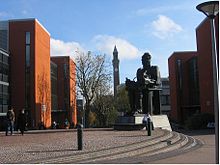
The university underwent a major expansion in the 1960s due to the production of a masterplan by Casson, Conder and Partners. The first of the major buildings to be constructed to a design by the firm was the Refectory and Staff House which was built in 1961 and 1962. The two buildings are connected by a bridge. The next major buildings to be constructed were the Wyddrington and Lake Halls and the Faculty of Commerce and Social Science, all completed in 1965. The Wyddrington and Lake Halls, on Edgbaston Park Road, were designed by H. T. Cadbury-Brown and contain three floors of student dwellings above a single floor of communal facilities.
The Faculty of Commerce and Social Science, now known as the Ashley Building, was designed by Howell, Killick, Partridge and Amis and is a long, curving two-storey block linked to a five-storey whorl. The two-storey block follows the curve of the road, and has load-bearing brick cross walls. It is faced in specially-made concrete blocks. The spiral is faced with faceted pre-cast concrete cladding panels.It was statutorily listed in 1993 and a refurbishment by Berman Guedes Stretton was completed in 2006.
Chamberlain, Powell and Bon were commissioned to design the Physical Education Centre which was built in 1966. The main characteristic of the building is the roof of the changing rooms and small gymnasium which has hyperbolic paraboloid roof light shells and is completely paved in quarry tiles. The roof of the sports hall consists of eight conoidal 2½-inch think sprayed concrete shells springing from 80-foot (24 m) long pre-stressed valley beams. On the south elevation, the roof is supported on raking pre-cast columns and reversed shells form a cantilevered canopy.

Also completed in 1966 was the Mining and Minerals Engineering and Physical Metallurgy Departments, which was designed by Philip Dowson of Arup Associates. This complex consisted of four similar three-storey blocks linked at the corners. The frame is of pre-cast reinforced concrete with columns in groups of four and the whole is planned as a tartan grid, allowing services to be carried vertically and horizontally so that at no point in a room are services more than ten feet away. The building received the 1966 RIBA Architecture Award for the West Midlands. It was statutorily listed in 1993. Taking the full five years from 1962 to 1967, Birmingham erected twelve buildings which each cost in excess of a quarter of a million pounds.
In 1967 Lucas House, a new hall of residence designed by The John Madin Design Group, was completed, providing 150 study bedrooms. It was constructed in the garden of a large house. The Medical School was extended in 1967 to a design by Leonard J. Multon and Partners. The two-storey building was part of a complex which covers the southside of Metchley Fort, a Roman fort. In 1968, the Institute for Education in the Department for Education was opened. This was another Casson, Conder and Partners-designed building. The complex consisted of a group of buildings centred around an eight-storey block, containing study offices, laboratories and teaching rooms. The building has a reinforced concrete frame which is exposed internally and the external walls are of silver-grey rustic bricks. The roofs of the lecture halls, penthouse and Child Study wing are covered in copper.
Arup Associates returned in the 1960s to design the Arts and Commerce Building, better known as Muirhead Tower. This was completed in 1969. A £42 million refurbishment of the 16-storey tower was completed in 2009 and it now houses the Colleges of Social Sciences and the [3] Cadbury Research Library, the new home for the University's Special Collections. The podium was remodelled around the existing Allardyce Nicol studio theatre, providing additional rehearsal spaces and changing and technical facilities. The ground floor lobby now incorporates a Starbucks coffee shop.[40] The name, Muirhead Tower, came from that of the first philosophy professor of the University John Henry Muirhead.
Currently in development is a 450-seat concert hall to complete the redbrick semi-circle of the Aston Webb building. This auditorium, with its associated research, teaching and rehearsal facilities, will house the Department of Music..
Other features

In 1973, University (Birmingham) railway station, on the Cross-City Line, was opened to serve the university and its hospital. It is the only university campus in Britain with its own railway station.
Located within the Edgbaston site of the university is the Winterbourne Botanic Garden, a 24,000 square metre (258,000 square foot) Edwardian Arts and crafts style garden. There has been much recent development on the western part of the campus. There are new academic buildings, including a learning resource centre and Computer Science department. The massive statue in the foreground was a gift to the University by its sculptor Sir Edward Paolozzi - the sculpture is named 'Faraday', and has an excerpt from the poem 'The Dry Salvages' by T. S. Eliot around its base.
The University of Birmingham operates the Lapworth Museum of Geology in the Aston Webb Building in Edgbaston. It is named after Charles Lapworth, a geologist who worked at Mason Science College. Since November 2007, the university has been holding a farmers' market on the campus. Birmingham is the first university in the country to have an accredited farmers' market.
The considerable extent of the estate meant that by the end of the 1990s it was valued at £536 million.
Selly Oak campus
The university's Selly Oak campus is a short distance to the south of the main campus. It was the home of a federation of nine higher education colleges, mainly focused on theology and education, which were integrated into the university for teaching in 1999. Among these was Westhill College (later the University of Birmingham, Westhill), which merged with the University's School of Education in 2001. The UK daytime television show Doctors is filmed on this campus. The University also has buildings at several other sites in the city.
History
Birmingham Medical School and Mason Science College

Although the earliest beginnings of the University were previously traced back to the Birmingham Medical School which is linked to William Sands Cox in his aim of creating a medical school along strictly Christian lines, unlike the London medical schools. Further research has now revealed the roots of the Birmingham Medical School in the medical education seminars of Mr John Tomlinson the first surgeon to the Birmingham Workhouse Infirmary, and later to the General Hospital. These classes were the first ever held outside London or south of the Scottish border in the winter of 1767-68. The first clinical teaching was undertaken by medical and surgical apprentices at the General Hospital, opened in 1779. The medical school which grew out of the Birmingham Workhouse Infirmary was founded in 1828 but Cox began teaching in December 1825. Queen Victoria granted her patronage to the Clinical Hospital in Birmingham and allowed it to be styled "The Queen's Hospital". It was the first provincial teaching hospital in England. In 1843, the medical college became known as Queen's College.
On February 23, 1875, Sir Josiah Mason, the Birmingham industrialist and philanthropist, who made his fortune in making key rings, pens, pen nibs and electroplating, founded Mason Science College. It was this institution that would eventually form the nucleus of the University of Birmingham. In 1882, the Departments of Chemistry, Botany and Physiology were transferred to Mason Science College, soon followed by the Departments of Physics and Comparative Anatomy. The transfer of the Medical School to Mason Science College gave considerable impetus to the growing importance of that college and in 1896 a move to incorporate it as a university college was made. As the result of the Mason University College Act 1897 it became incorporated as Mason University College on January 1, 1898, with the Right Honourable Joseph Chamberlain MP becoming the President of its Court of Governors.
Royal Charter
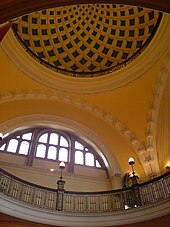
It was largely due to Chamberlain's tireless enthusiasm that the university was granted a Royal Charter by Queen Victoria on March 24, 1900. The Calthorpe family offered twenty-five acres (10 hectares) of land on the Bournbrook side of their estate in July. The Court of Governors received the Birmingham University Act 1900, which put the Royal Charter into effect, on May 31. Birmingham was therefore arguably the first so-called red brick university, although several other universities claim this title.
The transfer of Mason University College to the new University of Birmingham, with Chamberlain as its first Chancellor and Sir Oliver Lodge as the first Principal, was complete. All that remained of Josiah Mason's legacy was his Mermaid in the sinister chief of the university shield and of his college, the double-headed lion in the dexter. It became the first civic and campus university in England. The University Charter of 1900 also included provision for a Faculty of Commerce, as was appropriate for a university itself founded by industrialists and based in a city with enormous business wealth, in effect creating the first Business School in England. Consequently, the faculty, the first of its kind in Britain, was founded by Sir William Ashley in 1901, who from 1902 until 1923 served as first Professor of Commerce and Dean of the Faculty. From 1905 to 1908, Edward Elgar held the position of Peyton Professor of Music at the university. He was succeeded by his friend Granville Bantock.The heritage archives of the Univeirsty of Birmingham are accessible for research through the University's Special Collections.
Expansion
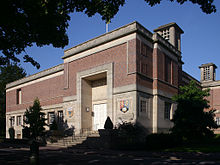
In 1939, the Barber Institute of Fine Arts, designed by Robert Atkinson, was opened. In 1956, the first MSc programme in Geotechnical Engineering commenced under the title of "Foundation Engineering", and has been run annually at the University of Birmingham since. It was the first geotechnical post-graduate school in England. The UK's longest-running MSc programme in Physics and Technology of Nuclear Reactors also started at the University of Birmingham in 1956, the same year that the world's first commercial nuclear power station was opened at Calder Hall in Cumbria. In 1957, Sir Hugh Casson and Neville Conder were asked by the university to prepare a masterplan on the site of the original 1900 buildings which were incomplete. The university drafted in other architects to amend the masterplan produced by the group. During the 1960s, the university constructed numerous large buildings, expanding the campus. In 1963, the University of Birmingham helped in the establishment of the faculty of medicine at the University of Rhodesia, now the University of Zimbabwe (UZ). UZ is now independent; however, student exchange programs persist.
Birmingham also supported the creation of Keele (formerly University College of North Staffordshire) and Warwick Universities under the Vice-Chancellorship of Sir Robert Aitken who acted as 'Godfather to the University of Warwick'. The initial plan was for a university college in Coventry attached to Birmingham but Aitken advised an independent initiative to the University Grants Committee.
Achievements
The university has been involved in many important inventions and developments in science. The cavity magnetron was developed at the university in the Physics Department by John Randall, Harry Boot and Jim Sayers. This was vital to the Allied victory in World War II. In 1940, the Frisch-Peierls memorandum, a document which demonstrated that the atomic bomb was more than simply theoretically possible, was written in the Physics Department. The university also hosted early work on Gaseous diffusion in the Chemistry department when it was located in the Hills building. Many windows in the Aston Webb building overlooking the former fume cupboards were opaque from being attacked by hydrofluoric acid well into recent years.
In 1943, Mark Oliphant made an early proposal for the construction of a proton-synchrotron, however he made no assurance that the machine would work. When phase stability was discovered in 1945, the proposal was resurrected and construction of a machine at the university that could surpass 1GeV. The university was aiming to construct the first machine to do this, however, funds were short and the machine did not start until 1953. They were beaten by the Brookhaven National Laboratory, who managed to start their Cosmotron in 1952, and get it fully working in 1953, before the University of Birmingham.
The discipline of cultural studies was founded at the University of Birmingham. Between 1964 and 2002, the campus was home to the Centre for Contemporary Cultural Studies, a leading research centre whose members' work came to be known as the Birmingham School of Cultural Studies. Despite being established by one of the key figures in the field, Richard Hoggart, and being later directed by the renowned theorist Stuart Hall, the department was controversially closed down.
The final round of the first ever televised leaders' debates, hosted by the BBC, was held at the university during the 2010 British general election campaign on the 29 April 2010. It will also act as a training camp for the Jamaican track and field team prior to the 2012 London Olympics.
Chancellors
Birmingham has had six Chancellors since gaining its royal charter in 1900. The current Vice-Chancellor is Professor David Eastwood. The first Chancellor of Birmingham was Joseph Chamberlain, he was the first commoner in 240 years to hold the post of Chancellor of a British university, and the first such chancellor ever not to have been a member of the Established Church.
| Name | Duration |
|---|---|
| The Rt Hon Joseph Chamberlain | 1900–1914 |
| The Rt Hon Robert Cecil, 1st Viscount Cecil of Chelwood | 1918–1944 |
| The Rt Hon Anthony Eden, Earl of Avon | 1945–1973 |
| Sir Peter Scott | 1973–1983 |
| Sir Alex Jarratt | 1983–2002 |
| Sir Dominic Cadbury | 2002–present |
Organisation
Academic departments

Being a large university Birmingham has departments covering a wide range of subjects. On August 1, 2008, the university's system was restructured into five 'colleges', which are composed of numerous 'schools':
- Arts and Law (Archaeology and Antiquity; Birmingham Law School; English, Drama and American & Canadian Studies; History and Cultures; Languages, Cultures, Art History and Music; Philosophy, Theology and Religion)
- Engineering and Physical Sciences (Chemistry; Chemical Engineering; Civil Engineering; Computer Science; Electronic, Electrical and Computer Engineering; Mathematics; Mechanical Engineering; Metallurgy and Materials; Physics and Astronomy)
- Life and Environmental Sciences (Biosciences; Geography, Earth and Environmental Sciences; Psychology; Sport and Exercise Sciences)
- Medical and Dental Sciences (Cancer Sciences; Clinical and Experimental Medicine; Dentistry; Health and Population Sciences; Immunity and Infection)
- Social Sciences (Birmingham Business School; Education; Government and Society; Social Policy)
The university is home to a number of internationally renowned research centres and schools, including the Birmingham Business School, the oldest business school in England (which is accredited by both AMBA and EQUIS), the University of Birmingham Medical School, which produces more medical doctors than any other university in Britain, the Institute of Local Government Studies, the Centre of West African Studies, the European Research Institute, the Centre of Excellence for Research in Computational Intelligence and Applications and the Shakespeare Institute.
Libraries and collections

The University of Birmingham's Special Collections contain a significant number of collections of rare books and manuscripts. Special Collections has a large number of pre-1850 books dating from 1471 with approximately 3 million manuscripts. Special Collections also contains the Chamberlain collection of papers from Neville Chamberlain, Joseph Chamberlain and Austen Chamberlain, the Avon Papers belonging to Antony Eden with material on the Suez Crisis, the Cadbury Papers relating to the Cadbury firm from 1900 to 1960, the Mingana Collection of Middle Eastern Manuscripts of Alphonse Mingana, the Noel Coward Collection, the papers of Edward Elgar, Oswald Mosley, and David Lodge, and the records of the English YMCA and of the Church Missionary Society. The university's Library Services department operates 10 libraries across the Edgbaston campus, Selly Oak campus, Birmingham City Centre and Stratford-upon-Avon.
NHS hospitals
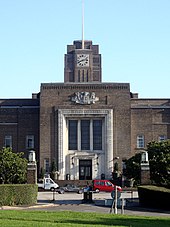
The University of Birmingham's medical school is one of the largest in Europe with well over 450 medical students being trained in each of the clinical years and over 1,000 teaching, research, technical and administrative staff. The school has centres of excellence in cancer, immunology, cardiovascular disease, neuroscience and endocrinology and renowned nationally and internationally for its research and developments in these fields. The medical school has close links with the NHS and works closely with 15 teaching hospitals and 50 primary care training practices in the West Midlands.
The University Hospital Birmingham NHS Foundation Trust is the main teaching hospital in the West Midlands. It is very successful and has been given three stars for the past four consecutive years. The trust also hosts the Royal Centre for Defence Medicine, based at Selly Oak Hospital, which provides medical support to military personnel such as military returned from fighting in the Iraq War.
Off-campus establishments
A number of the university's centres, schools and institutes are located away from its two campuses in Edgbaston and Selly Oak:
- The School of Dentistry, in Birmingham City Centre
- The Shakespeare Institute, in Stratford-upon-Avon
- The Ironbridge Institute, in Telford, which offers postgraduate and professional development courses in heritage
- The Raymond Priestley Centre, near Coniston in the Lake District, which is used for outdoor pursuits and field work
University of Birmingham Observatory
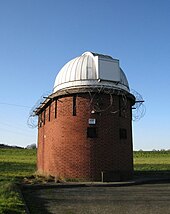
The University of Birmingham Observatory is used primarily for undergraduate teaching at the University of Birmingham. It has two main instruments, a 16" Cassegrain (working at f/19) and a 14” Meade LX200R (working at f/6.35). A third telescope is also present and is used exclusively for visual observations.
Undergraduates of the Physics & Astrophysics programmes use the observatory in their 2nd and 3rd years. In the 2nd year they use this for prime focus imaging (e.g. light curve of an eclipsing binary, orbit of a comet) and in the 3rd year they use it for spectral analysis of celestial bodies (e.g. the wind speed of a P-Cygni star, the distance to a nearby Seyfert galaxy).
Reputation
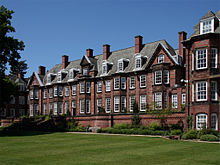
In October 2009, the University was ranked 10th in the UK and 66th best in the world by THE-QS World University Rankings (known from 2010 onwards as the QS World University Rankings). The university is ranked 22nd in The Times 2010 Good University Guide, and 24th in The Guardian's 2010 rankings. It is rated 11th in the UK, 30th in Europe and equal 91st best university in the world in the 2008 Institute of Higher Education, Shanghai Jiao Tong University (IHE-SJTU) Academic Ranking of World Universities, and 85th-87th by Global University Ranking.
Owing to Birmingham's role as a centre of light engineering, the University traditionally had a special focus on science, engineering and commerce, as well as coal mining. It now teaches a full range of academic subjects and has five-star rating for teaching and research in several departments; additionally, it is widely regarded as making a prominent contribution to cancer studies, hosting the first Cancer Research UK Centre.
The University is particularly known for its research. In the 2001 Research Assessment Exercise, two thirds of The University's departments ranked nationally or internationally outstanding. Languages, mathematics, biological sciences, physiotherapy, sociology and electrical and electronic engineering all recorded maximum points. It was rated fifth in the UK for research quality, with 32 departments holding a 5 or 5* rating.[10] The Department of Political Science and International Studies (POLSIS) ranked 4th in the UK and 22nd in the world in the Hix rankings of political science departments. The sociology department also ranked 4th by the Guardian University guide. According to the results of the Research Assessment Exercise 2008, 90% of the University of Birmingham’s research activity has international impact. The Research Fortnight’s University Power Ranking, based on quality and quantity of research activity, put the University of Birmingham 12th in the UK, leading the way across a broad range of disciplines including Primary Care, Cancer Studies, Psychology and Sport and Exercise Sciences.
As is the case with all of the 'redbrick' civic institutions, the University of Birmingham holds a sizeable student body and teaches a comparatively broader range of courses than smaller institutions. After taking up his post as vice-chancellor in April 2009, David Eastwood said:
When I was appointed, people described this university as a sleeping giant, and there is this feeling that although this is a great university, we could do even better. This is a university which can do yet more and I am here to play my part. That is the challenge, but it's not an easy challenge as we are competing in a global environment. We have some terrific, genuinely global leading research at this university, but we need to build on our research strengths and increase further the quality of our research and the impact of our research. Cancer research is as good here as anywhere, we have one of the best three psychology courses in the country, the best music departments and best sports science degrees in the country, and very good engineering. One of the great attractions of this university is that we have the breadth that other universities dream of, but it's fundamentally about building on our strengths.[72]
Student life
Guild of Students
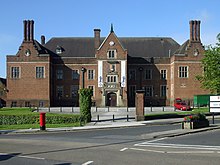 University of Birmingham Guild of Students
University of Birmingham Guild of StudentsThe University of Birmingham Guild of Students is the university's student union. Originally the Guild of Undergraduates, it is unclear when the Guild was formally established. It is also not certain why it is called the Guild of Students and not the Union of Students; it is widely thought among Guild officers and staff that the university imposed this name at the Guild's genesis to avoid socialist and working class connotations in favour of more professional ones. the Guild shares its name with Liverpool Guild of Students. Both organisations subsequently founded the National Union of Students. The Union Building, the Guild's bricks and mortar presence, was designed by the architect Holland W. Hobbiss.
The Guild's official purposes are to represent its members and provide a means of socialising, though societies and general amenities. The university provides the Guild with the Union Building effectively rent free, and a block grant. In 2005-6, this grant amounted to approximately £1.2 million, roughly equivalent to £50 per student.
The Guild undertakes its representative function through its officer group, seven of whom are full time, on sabbatical from their studies, and ten of whom are part time and hold their positions whilst still studying. Elections are held yearly, conventionally February, for the following academic year. These officers have regular contact with the university's officer-holders and managers. In theory, the Guild's officers are directed and kept to account over their year in office by Guild Council, a 500 seat pseudo-legislature. The Guild also supports the university "student reps" scheme, which aims to provide an effective channel of feedback from students on more of a departmental level.
The Guild supports a variety of student societies and volunteering projects, roughly around 180 at any one time. The Guild was the UK's first student union with a television studio Guild , one of the first to broadcast its radio station BurnFM.com online, and one of the few still to publish its campus newspaper, Redbrick, weekly.
The Guild of Students was where the international volunteering charity InterVol was conceived and developed, initially as a student . Another two of the Guild's long-standing societies are Student Advice and Nightline (previously Niteline), which both provide peer-to-peer welfare support. The Guild complements these societies and volunteering projects with professional staffed services, including its walk-in Advice and Representation Centre (ARC), Student Development, Job Zone, Student Mentors in halls, and Community Wardens around Bournbrook.
The Guild also runs several bars, eateries, social spaces and social events.
Housing
The university provides housing for most first-year students, running a guarantee scheme for all those UK applicants who choose Birmingham as their firm UCAS choice. 90 per cent of university-provided housing is inhabited by first-year students.
The university has spent the last few years re-organising their accommodation offering. The university maintained gender-segregated halls until 1999 when Lake and Wyddrington "halls" (treated as two different halls, despite being physically one building) was reborn as Shackleton. University House was decommissioned as accommodation to house the expanding Business School, while Mason Hall has been demolished and rebuilt, opening in 2008. Shackleton is now the only hall providing catering, although other students are welcome to join its meal plan. In the summer of 2006, the university sold three of its most distant halls (Hunter Court, the Beeches and Queens Hospital Close) to private operators, while later in the year and during term, the university was forced urgently to decommission both Chamberlain Tower and Manor House over fire safety inspection failures. The university has rebranded its halls offerings into three villages.
Vale Village
The Vale Village includes Chamberlain Hall, Shackleton, Maple Bank, Tennis Court, Elgar Court, Aitken and Chelwood residences. A sixth hall of residence, Mason Hall, re-opened in September 2008 following a complete rebuild. Approximately 1,900 students live in the village.
 The Vale Village, overlooking Shackleton Hall
The Vale Village, overlooking Shackleton HallShackleton Hall underwent an £11 million refurbishment and was re-opened in Autumn 2004. There are 72 flats housing a total of 350 students. The majority of the units consist of six to eight bedrooms, together with a small number of one, two, three or five bedroom studio/apartments The redevelopment was designed by Birmingham-based archtitect Patrick Nicholls while employed at Aedas now a director of Glancy Nicholls Architects.Maple Bank was refurbished and opened in summer 2005. It consists of 87 five bedroom flats, housing 435 undergraduates. The Elgar Court residence consists of 40 six bedroom flats, housing a total of 236 students. It is the newest residence to be built, opening in September 2003. Tennis Court consists of 138 three, four, five and six bedroom flats and houses 697 students. The Aitken wing is a small complex consisting of 23 six and eight bedroom flats. It houses 147 students. Chelwood is situated at the top of the Vale village overlooking the lake, and comprises 50 en-suite bedrooms.
Construction of Mason Hall commenced in June 2006. It has been designed by Aedas Architects who submitted the design in August 2005. Norwest Holst Ltd are the contractors, and Couch Perry Wilkes are the services engineers, DTA are the structural engineers, Faithful & Gould are the quantity surveyors and CDM Project Safety are the planning supervisors. The entire project is expected to cost £36.75 million.
The largest student-run event at the university, and indeed possibly in the UK, is also held on the Vale. The Vale Festival is a large annual music festival, attracting crowds of over 5,000 and boasting over forty bands across five stages and a multitude of other activities and events. It raises over £30,000 a year for charities.
Pritchatts Park Village
The Pritchatts Park Village houses over 700 students both undergraduate and postgraduate students. Halls include 'Ashcroft', 'The Spinney' and 'Oakley Court', as well as 'Pritchatts House' and the 'Pritchatts Road Houses' The Spinney is a small complex of six houses and twelve smaller flats, housing 104 students in total. Ashcroft consists of four purpose built blocks of flats and houses 198 students.The four-storey Pritchatts House consists of 24 duplex units and houses 159 students. Oakley Court consists of 21 individual purpose-built flats, ranging in size from five to thirteen bedrooms. Also included are 36 duplex units. A total of 213 students are housed in Oakley Court, made up of undergraduates.Oakley Court was completed in 1993 at a cost of £2.9 million. It was designed by Birmingham-based Associated Architects. Pritchatts Road is a group of four private houses that were converted into student residences. There is a maximum of 16 bedrooms per house. Pritchatts Park hosts the now annual Pritchattsbury, a student-run music festival raising money for charity.
Accommodation at Five Ways
Other Self-catering student accommodation include The Beeches, which is small with 48 flats housing 240 undergraduate students on the outskirts of the village.Hunter Court, also located on the outskirts of the village, consists of 64 flats with five and some seven study bedrooms and houses 332 undergraduate students. Queens Hospital Close, located on the outskirts of the village near Broad Street, consists of 52 units of mainly six study bedrooms and some eight and ten bedroom flats. It houses 330 students.
Selly Oak Village
Selly Oak Village consists of three residences; Jarratt Hall, Douper Hall and Victoria Hall. The term ‘Selly Oak Village’ is rather misleading here, for despite its name the halls themselves are actually located in Bournbrook rather than in Selly Oak. The village has 637 bed spaces for students. Douper Hall consists of 28 flats accommodating from two to six persons for 117 undergraduate and postgraduate students. Jarratt Hall is a large complex designed around a central courtyard and three landscaped areas. It houses a mixture of 620 undergraduate and postgraduate students.
Non-university accommodation
Until recently, the university had not been served by many private halls; a sole Victoria Halls was built in 2001. However, alongside the former university halls of Hunter Court, the Beeches and Queens Hospital Close, a number of other private halls aimed at the University of Birmingham market opened for business in 2007, such as Opal 1 on Bristol Road and IQFive on Bath Row near Five Ways.
A large number of students cohabit in rented houses, mainly in the Bournbrook area. However an increasingly large number of students are thought to be local, continuing to live in the family home.
University Sport
 One of the many university athletics fields
One of the many university athletics fieldsThe university has many successful sports teams and has been consistently ranked in the top four of the British Universities & Colleges Sport (BUCS) league table.The university's reputation for sport is a long-standing one; in 1954 it became the first UK university to offer a sports degree, and until 1968 exercise was compulsory for all students. In 2004 six graduates and one current student competed in the Athens olympic games. Four alumni competed at the Beijing Olympic Games in 2008, including cyclist Paul Manning who won an Olympic Gold. The university will host the Jamaican track and field team prior to the 2012 London Olympics
University of Birmingham Sport (UBS) offers a wide range of competitive and participation sports, which is utilised by the student and local population of Birmingham. Alongside fitness classes such as yoga and aerobics, UBS offers over 40 different sport teams, including rowing, cricket, football, rugby union, field hockey, American football (Birmingham Lions), triathlon and many more. The wide selection has ensured the university has remained one of the country's most active and colourful campuses with over 2000 students participating in sport.
UBS offers over 40 scholarships and bursaries to national and international students of exceptional athletic ability.
The university sports centre was originally designed to have the swimming pool on stilts. The design had to be revised once it was realised that the structure would be unable to support the weight of water. The model of the university in the Great Hall shows the original design.
In popular culture
David Lodge's novel Changing Places tells the story of exchange of professors between the universities of Rummidge and Euphoric State, Plotinus, thinly disguised fictional versions of Birmingham and UC Berkeley, which in the book both have replicas of the Leaning Tower of Pisa on campus.
The university campus has been used as a filming location for a number of film and television productions, particularly those of the BBC which has a presence at the university's Selly Oak campus, the BBC Drama Village. Scenes from the John Cleese film Clockwise were filmed at the campus' east entrance, while several episodes of the BBC detective series Dalziel and Pascoe, daytime soap Doctors and CBBC series Brum have been filmed in and around campus. Interior and exterior scenes for a BBC adaptation of Birmingham alumnus David Lodge's novel Nice Work and BBC comedy drama A Very Peculiar Practice were also shot in and around the University campus and halls of residence with a number of students appearing as extras. A trailer for the BBC's Red Nose Day 2007, featuring Lou and Andy from Little Britain, was filmed near the School of Biosciences. More recently, an episode of the BBC show Hustle was filmed on campus with interior and exterior shots of the Aston Webb building, in addition to internal shots of the School of Biosciences.
Post punk band Joy Division played their final gig at the University High Hall on May 2, 1980 (now known as Chamberlain Hall), 16 days before the suicide of singer/songwriter, Ian Curtis. A recording of the performance accompanies the Still compilation album. It includes one of only two available recordings of the song "Ceremony" (the other being a demo rehearsal), which would later become a single for New Order. Fairport Convention recorded much of the live album "Farewell, Farewell" at Lake Hall during the May Ball on 11 May 1979, using the Island Records mobile studio.
Branding
 The University's logo from the 1980s until 2005
The University's logo from the 1980s until 2005The original coat of arms was designed in 1900. It features a double headed lion (on the left) and a mermaid holding a mirror and comb (to the right). These symbols owe to the coat of arms of the institutions predecessor, Mason College.
In 2005 the university began rebranding itself. A simplified edition of the shield which had been introduced in the 1980s reverted to a detailed version based on how it appears on the university's original Royal Charter. After a research project into the image of the university, it was decided that a separate logo was required to redefine the institution as modern and contemporary. A new 'word marque', using the "U and B" letters and the Baskerville font (in honour of the Birmingham printer John Baskerville) is used as the primary logo when trying to attract both prospective investors and students. It is also found on campus vehicles. The traditional coat of arms, by contrast, appears on degree certificates and academic documents. The introduction of new signage throughout the campus, featuring the shield rather than the "U and B" logo, was completed at the end of 2006.








0 comments:
Post a Comment